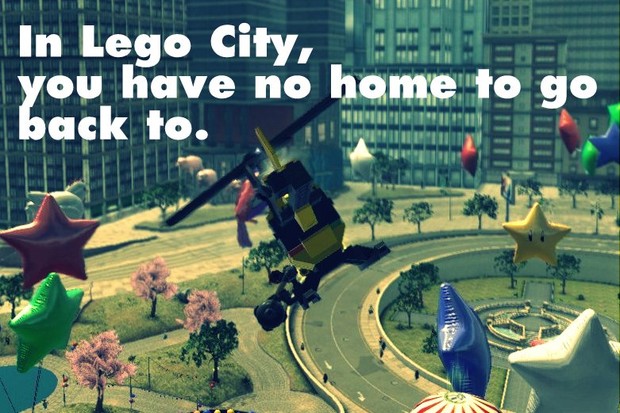When Tom Bissell wrote about Grand Theft Auto for The Guardian, he brought the high-minded cultural elite’s attention to Rockstar Games’ massively popular series. His credibility as a journalist and novel writer lent a critical weight to a discussion long-confined to the shallow dialogue of commercial review. The essay dealt with the game as a piece of art; it also dealt with his own fall from productivity while lost in the throes of Rockstar’s work. He acknowledges his own limitations, imbues the game with a kind of Bizarro Neverland force, a place for childish adults to wreak havok.
Bissell contends that, “[m]ost games are about attacking a childlike world with an adult mind. The GTA games are the opposite.” Extrapolated: Grand Theft Auto and its many iterations are about attacking an adult world with a childlike mind. The end result is hijinx-soaked pubescent fantasy.
So why are many open-world games, like GTA or Saints Row, thought of as “adult” or “mature” titles? It’s an old irony, but one fresh in my mind since reviews for another open-world game emerged. According to various international outlets, LEGO City Undercover for the Wii U is: “Grand Theft Auto for kids”; “the ideal game for younger gamers who might not be the appropriate age for… Grand Theft Auto” ; and “a Wii U exclusive that tries its best to realize children’s dreams.” Stephen Totilo of Kotaku calls the main story “made for my nephew more than it’s made for me…a lot of it feels juvenile and will be the toughest part of this game for grown-ups to swallow.”
The comparison implies GTA and its ilk are for the well-seasoned among us. In other words, the old. Those who’ve evolved beyond brightly-colored blocks. Why destroy pretend buildings when you can destroy pretend people? The idea of GTA as a game for mature players has always struck me as patently false, an affront to my notion of adulthood. Elders may exercise a “childlike mind” here, sure, but kids should seek out a primary colored alternative. Allow me a rebuttal. LEGO City Undercover is, finally, after long wait, the first open-world game for adults.
Gamestop employees should be required to check IDs of prospective LEGO City buyers and not sell it to anyone under twenty-eight. Undercover is for those who have watched Dirty Harry and understand a joke about an over-caffeinated cop, and whether he already had five shots of espresso or six; for those with a nine-to-five dayjob, whose working person’s finite play schedule demands digestible missions, the wild expanse of its sandbox limited and fragmented for someone not on summer vacation. Excessive load times mar the beginning of each major chapter, a progress bar filling up over the course of thirty seconds.
Luckily, patience is a skill borne from experience in the real-world, where sitting at the DMV for hours prepares us for a life hinging on unfair consequences and unnecessary sacrifice. To a kid the cesura of stimuli aches; to one who commutes to work, sitting in traffic an hour each way, the minute of inaction is a welcome break from the noise.
LEGO City Undercover makes the player laugh. During an early cut-scene where the Chief of Police is explaining protocol, a custodian enters with a vacuum-cleaner, whose volume dominates the Chief’s careful instructions. Later, Frank Honey, your over-eager partner who should win Best Supporting Actor next awards season, watches video of the villain projected onto the wall, its proportions blown up to fill the room. “It’s a giant…” he murmurs, a line that loses its potency on the page but is one of the dozens Monsieur Honey spouts that turned up my funny boner.
Martin Scorcese’s Goodfellas released in 1990, and a five-year-old on opening day would be the required minimum age to enjoy LCU to the fullest. One chapter in the game borrows a classic scene from the film, viewed from the perspective of Ray Liotta’s Henry Hill as he enters the hangout of his new accomplices. The camerawork even appropriates director of photography Michael Ballhaus’s famous steadycam shot, walking through the bar and introducing notable grunts like Johnny One-Time, “because he says everything one time.”

The name itself is a good gag. But then the camera pivots back to his face after he says his line, waiting for the repeated phrase as it happened in the film, only to show Johnny looking awkward, like, “Why are you still looking at me?” The characters don’t know they’re in a parody. But they’re treated like they should. When we reach a Joe Pesci-soundalike with his back to us and he spouts the memorable line, “You think I’m funny? Funny how?” I chuckle for no reason but am mildly disappointed in the easy joke. Then he swivels in his chair, revealing a rainbow wig and a red squeeky nose — he’s a clown! Of course he’s funny. As long as you were born in the Eighties.
Grand Theft Auto is funny, too, and so is Saints Row. But the humor is wrapped in suffering: a poison-soaked date wrapped in sweet bacon. It tastes good at first, but underneath lies revulsion. LEGO City provides something adults need more than children: levity. Children laugh easily, with little provocation; adults, less so. The toil of discovery dulls the act’s inherent shine. Adults know strife, disease, tragedy, death. They know true fatigue. Disappointment. The numbing effect of routine. They need games like Undercover where clever quips come in thirty-second intervals, where sight gags break fourth-wall conventions to comic effect. Each time I play I laugh out-loud, consistently, with no one else in the room. It’s hard to remember the last time I’d done so, playing a game or otherwise.
This isn’t escapism. This is a return to being open to joy for its own sake, when so much of what is deemed “mature,” not only in videogames but in our daily life, revolves around the diminuation of others.
Of course, this is a LEGO game, a toy many adults have long put away before their reintroduction during child-rearing. As such, the landscape of LEGO City is peppered with endless knick-knacks, the detritus of a clumsy builder, the better to gather and hoard. That such emphasis is put on a repetitive collection of things is another sign this game is for adults. Each object taken in is counted up, registered as one out of fifteen, or 30 out of 1000. You’re tasked with meticulously finding and procuring large sums of arbitrary refuse: mega blocks, super builds, circular face tokens, like so many phone numbers in a rolodex.
Kids bore easily. They play with their toy for five minutes, drop it, and move onto the next. Their patience starts thin and thins rapidly. But adults are familiar with the slog. They — We — live through the grind. We check in, toil, clock out. We stare at the same face across the dinner table night after night and watch as it crinkles. Each year we jab another wax-coated match into frosting, light them up, and blow them out even before they’ve begun to burn. What’s the sense in that? There is little.
But we do it anyway, just as we feel compelled to run through the streets of LEGO City and acquire golden studs scattered everywhere, punch through perfectly fine benches and flower pots just to collect the erupting scrap, because it’s all there and so are we. We have nothing but time and this innate urge to get what’s ours, grab it all and check it off the list one two three: a degree, a job, a spouse, a kid, a house. It’s telling that your character is named Chase.

LEGO City Undercover reveals itself as another drip-feed for the Joneses, a bottomless box of carrots, no stick required. In LEGO City, you have no home to go back to. Others call you on your communication device represented by the Wii U GamePad, a screened lifeline adults (and kids, too) are all too familiar with. They tell you what to do, and you do it. Not because of any innocent whim. You’re responsible, a capital A- Adult. But that doesn’t mean you’re too old for child’s play.
Then again, play comes in many forms. Besides his obsessive playing of Grand Theft Auto IV, Bissell’s essay deals with his then-addiction to cocaine. He connected one to the other, sketching the dual pursuits as a hungry snake swallowing its own tail, exhilarated by the paradox of being nourished by its own waste. To remove yourself from the world through drug abuse is a childish pushing away of reality. One could say the same about playing too many games.
Maybe if he’d been exploring LEGO City Undercover, Bissell wouldn’t have needed the false high. But who’s to say? Perhaps if I explored more deeply those same childish reservoirs, remaining open to the pure delight of messy imperfection, I wouldn’t have, either.
DEVELOPER: TT Fusion / Nintendo
DESIGNERS: Loz Doyle / Masakazu Miyazaki
PLATFORM: Wii U
PUBLISHER: Nintendo